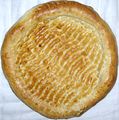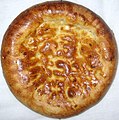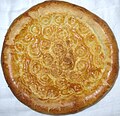 | |
| Type | Tandoor bread |
|---|---|
| Place of origin | |
Tandyr nan is a type of Central Asian bread [1] [2] cooked in a vertical clay oven, the tandyr or tandoor. It is circular and leavened with yeast, and typically has a crisp golden surface. They are often decorated by stamping patterns on the dough, and can be topped with ingredients like sesame seeds, nigella seeds, or thinly sliced onion. [3]
Preparation
Large tandyr ovens used to bake nan as well as cook meat are typically located outdoors. Unlike Indian tandoor ovens, in Central Asia the tandyr can be used in a vertical or horizontal position, although the bread is always baked in the fashion of a vertical oven, with the bread stuck onto the inner walls of the oven. [1] The leavening can derive from sourdough starter, as is traditional, or from brewers yeast. [1] Several filled variants of the bread exist, such as Uyghur gosh nan and Turkmen atli nan. Bakers of nan are called nonvoys. [4]
Designs
Nan is often decorated with a central design in the shape of a circle consisting of patterned dots. This design is created with a stamp known in Uzbekistan as a chekich or in Turkmenistan or by Uyghurs in Xinjiang as durtlik. [1] [4] In addition to giving each bakery's nan a distinct design, the holes created by the chekich allow steam to rise from the flattened interior part of the nan. A radial pattern of slashes or dots can also be added with a bosma, a tool often made with reused bicycle spokes. [1] [3] Other bakers may use a chekich several times on the surface of their nan. [3] Nan for festive occasions may have more elaborate designs or color added. Nan for engagements is often colored pink and yellow. [3] [4]
Cultural significance
The examples and perspective in this section deal primarily with Uzbekistan and do not represent a
worldwide view of the subject. (December 2023) |
In Uzbek culture, non has great cultural importance and is used in many ceremonies marking phases of life. Newborn babies have non placed under their heads to symbolize long life, and toddlers learning to walk have non placed between their legs to signify wishes of a blessed journey through life. Non is an essential wedding food, and on the day of the wedding, a bride and groom take bites of a non each, and finish it the following morning for their first breakfast as husband and wife. A similar tradition is also done when a son leaves for military service or to work or study abroad: the son will take bites of two non and they will be dried and hung on the ceiling until he returns. [3] [4]
Non is treated as an important object, and should not be placed on the ground or cut with a knife (it is almost always broken by hand). If non is dropped, it should be placed on a wall or in a tree for birds, and the phrase aysh Allah (God's bread) is spoken aloud. [3]
Names
- Kazakh, Kyrgyz: nan (нан), tandyr nan (тандыр нан)
- Tajik: non (нон)
- Turkmen: tamdyr çörek
- Uyghur: nan (نان), tonur nan (تونۇر نان)
- Uzbek: non, tandir non
- Chinese: náng (馕; 饢)
- Russian: lepyoshka (лепёшка), tadyrnaya lepyoshka (тандырная лепёшка)
Varieties
Obi non
Obi non or lepyoshka (лепёшка, "flatbread"), is a kind of flatbread in Afghan, Tajik and Uzbek cuisine. It is shaped like a disc and thicker than naan. Obi non are baked in clay ovens called tandyr. [5] [6]
Tohax
Tohax (тоқаш/toqash, токоч, توغاچ, Тоғач, Samarqand noni/Самарқанд нони), also known as toqach or toghach, is a type of tandoor bread consumed within the Xinjiang Uyghur Autonomous Region [7] of China, as well as in many regions of Central Asia ( Kazakhstan, Kyrgyzstan, Uzbekistan). [8]
Gallery
-
Chon-nan
-
Pitir-nan
-
Pitir-nan2
-
Tohax-nan
-
Tashkent-style non
-
Samarkand-style non
-
Tandyr nan sold in Kyrgyzstan
See also
References
- ^ a b c d e Pasqualone, Antonella (2018-03-01). "Traditional flat breads spread from the Fertile Crescent: Production process and history of baking systems". Journal of Ethnic Foods. 5 (1): 10–19. doi: 10.1016/j.jef.2018.02.002. hdl: 11586/217814. ISSN 2352-6181.
- ^ "Recipe: Tandyr nan – British-Kazakh Society". Archived from the original on 2016-03-05. Retrieved 2019-01-13.
- ^ a b c d e f Hansen, Eric. "The Fabled Flatbreads of Uzbekistan". Aramco World. Retrieved 8 December 2023.
- ^ a b c d "You Can Have Your Bread and Stamp It Too". Atlas Obscura. Retrieved 2023-12-08.
- ^ "Obi-Non (Lepyoshka)". orexca.com/. Archived from the original on 27 July 2018. Retrieved 20 February 2010.
- ^ Mehnat. "Uzbek National Cuisine". Retrieved 20 February 2010.
- ^ Xinjiang Restaurant
- ^ В. В. Похлебкин, Национальные кухни наших народов, Москва, Центрполиграф, 2004, ISBN 5-9524-2783-9, ISBN 978-5-9524-2783-9 ( William Pokhlyobkin, National Cuisines of our Peoples, Moscow, Centrpoligraf, 2004).









